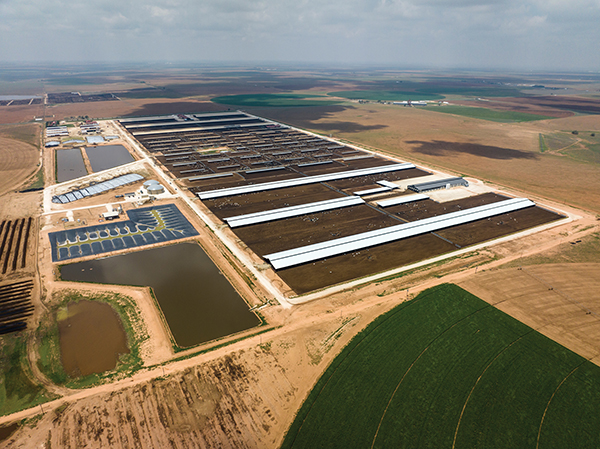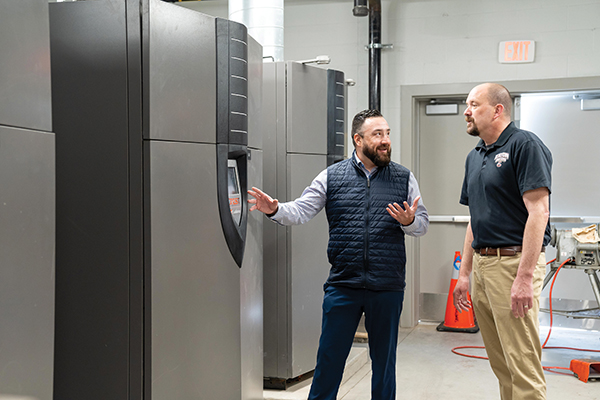
The resiliency of the natural gas infrastructure system fuels the industrial sector with affordable, reliable and abundant energy that is crucial in manufacturing and industrial processes and in helping businesses achieve their operational, financial and sustainability goals now and for years to come. A healthy and profitable industrial business sector is a cornerstone for a strong national economy and thriving communities.
How Can Natural Gas Help Attract Industrial Businesses?
Industrial businesses require fuel sources based on their specific processes, operational and financial goals, environmental considerations and location. Natural gas is reliable, affordable, efficient and abundant energy that can check all these boxes, which is why natural gas accounts for the largest share of U.S. manufacturing energy consumption.1
“Cost, reliability and environmental benefits are of the utmost importance in choosing an energy source for industrial customers,” said Ryan Bates, Atmos Energy senior industrial account manager. “Natural gas is an efficient and economical energy source that provides the reliability these customers demand.”
The U.S. Energy Information Administration (EIA) reports that there are approximately 182,000 industrial customers nationwide, yet in the past year those customers accounted for approximately one-third of all natural gas use. Overall, natural gas provides nearly 25 percent of all energy in the U.S. and is an essential part of the nation’s energy sector and economy. According to the American Gas Association, the country’s natural gas industry delivers affordable, efficient and reliable energy to more than 187 million Americans and approximately 5.5 million businesses.2
For many industrial users, natural gas is required for their operations. The chemical industry, which is the largest consumer of natural gas in the industrial sector, uses natural gas to create heat, generate electricity or serve as a feedstock to produce methanol, fertilizer, hydrogen and other chemicals. In addition, some processes, such as metallurgical heat treatment, require consistent and precise high-intensity temperatures that can only be achieved with natural gas. Natural gas plays a key role in the manufacture of electric vehicles and EV batteries, windmills, circuit boards and many other high-tech renewable energy products.1
What Is the Value Proposition for Natural Gas?

America’s abundant natural gas resources and extensive infrastructure satisfy current and future domestic energy demand while keeping prices affordable and stable for decades into the future. According to the American Gas Association, commercial and industrial businesses have saved more than $500 billion over the last decade by using natural gas.2
The natural gas industry has a proven track record of reducing emissions from its operations and working with industrial customers to reduce their environmental impact. Since 1990, emissions from natural gas distribution systems have declined 69 percent.2
Some natural gas utilities offer financial incentives and energy assessments to industrial and large businesses to assist in lowering energy and emissions. These programs can help identify inefficient processes and equipment, in addition to providing rebates for installing high-efficiency equipment and tune-ups for existing equipment.
“Atmos Energy’s industrial customers in Mississippi, Louisiana and Colorado are able to leverage the SmartChoice energy efficiency program,” said Lance Coe, Atmos Energy senior industrial account manager. “In Mississippi, we offer free energy assessments to help identify potential energy-saving projects. If a customer chooses to complete a project such as boiler upgrades or replace or install Energy Star-rated equipment, we provide financial incentives based on the amount of energy savings. This improves our customers’ return on investment for the short and longer term.”
In Eaton, Colorado, the school district leveraged Atmos Energy’s SmartChoice program to provide $48,500 in incentives for high-efficiency boilers, hot water equipment, advanced boiler controls, demand-controlled ventilation and destratification fans in a new high school building. In addition, existing elementary and middle school facilities retrofitted existing heating systems and installed destratification fans in their gyms. These upgrades are anticipated to reduce annual greenhouse gas (GHG) emissions by 462 metric tons of carbon dioxide and save the Eaton School District 87,000 therms of natural gas annually.
In North America, natural gas utilities spent nearly $1.6 billion on energy efficiency-related expenditures in 2020 for all customer classes, saving approximately 325 million therms of energy. Spending on energy efficiency programs by natural gas utilities has increased by 391 percent since 2007. 2
Natural Gas Is Reliable
Industrial users require reliable and abundant energy they can count on for continuous operations. The U.S.’s natural gas infrastructure is well established, with more than 2.6 million miles of underground pipelines, including approximately 2.3 million miles of local utility distribution pipelines and 300,000 miles of transmission pipelines. Because natural gas is delivered through underground pipelines, it is the safest form of energy delivery, which also makes it less prone to outages. According to the American Gas Association, only one in 800 natural gas customers experience an unplanned outage in any given year, compared to electric distribution systems that average one outage per customer every year. 2
Industrial users that utilize solar and wind power know that renewable power can be intermittent. Therefore, a reliable fuel source like natural gas is essential to handle on-demand loads quickly when solar and wind power are not available.
When power outages occur due to equipment malfunctions, severe weather or grid interruptions, permanent natural gas backup generators provide the industrial sector with energy reliability to seamlessly continue critical operations and processes. In addition to providing a continuous source of power during an interruption, backup generation can also supplement electric load during peak hours and provide generation capacity to offset coincident peak demand.
Natural Gas Is Abundant and Produced in the U.S.

The domestic production of natural gas helps to maintain the resiliency of the nation’s energy system. In September, the Potential Gas Committee (PGC) released its year-end assessment of the nation’s estimated natural gas resource base. The PGC stated that future gas supply now totals 3.98 trillion cubic feet (Tcf), which is an increase of 3.6 percent from the comparable 2020 year-end estimate. This continues to validate that the U.S. has more than 100 years of natural gas supply. 2
“These evaluations are critically important to help ensure that policymakers, regulators and other key stakeholders understand the potential of natural gas supplies in the United States,” said Richard Meyer, AGA vice president of energy markets, analysis and standards. “Future gas supplies continue to increase as the energy industry innovates, improves processes, optimizes resources, invests in efficiency and reduces emissions.”
Recent short-term estimations by the EIA include a continued increase in natural gas production through 2027 and projections that natural gas prices will remain stable through 2024. For the longer term, EIA expects natural gas production to rise to 42.1 Tcf by 2050. The American Gas Association also projects that natural gas will be one-half to one-third the price of other fuels through 2050.1, 2
Natural Gas Is Resilient and Innovative
The resiliency of the natural gas infrastructure provides a unique advantage of fueling innovative energy technologies for the industrial sector that lower energy use, reduce carbon emissions and increase power reliability. It is the catalyst for innovative energy-efficient and carbon-reducing technologies such as renewable natural gas (RNG), combined heat and power (CHP) and fuel cells.
Renewable natural gas is carbon-neutral fuel derived from organic sources to fuel homes, businesses and even vehicles. RNG lowers overall GHG emissions, is 100 percent compatible with existing natural gas supply and is derived from sources that include landfills, animal and food waste, water resource recovery facilities, agricultural residues, forest product residues and municipal solid waste. These producers capture and convert methane emissions into a renewable energy source, thus preventing methane from migrating directly into the atmosphere.
Combined Heat and Power (CHP) is an efficient and lower carbon approach to generating power and thermal energy from a single fuel source, which is typically natural gas. CHP systems provide at least a portion of a facility’s electrical load and capture excess heat from exhaust systems for use in space heating, cooling, hot water, dehumidification and/or process heating. CHP systems operate in a variety of energy-intensive facilities such as industrial manufacturing, college campuses, hospitals, airports, municipal facilities, multifamily housing and planned communities.
“To fully realize the benefits of CHP and achieve maximum savings, the user must have a large thermal load,” explained Bates. “CHP systems provide cost and energy savings by increasing the overall efficiency of plant systems using waste heat to generate power and/or steam, thus reducing overall energy consumption by approximately 25 percent versus purchasing grid power and natural gas separately.”
According to Bates, another major benefit of a CHP system is electric grid resiliency. In the event of a natural disaster or widespread power outage, the CHP system will generate onsite power for continued operations.
A fuel cell is a device that generates electricity through an electrochemical reaction, not combustion. In a fuel cell, hydrogen and oxygen are combined to generate electricity, heat and water. According to the Fuel Cell and Hydrogen Energy Association, this technology is used today in a range of applications like providing power to homes and businesses, keeping critical facilities like hospitals, grocery stores and data centers up and running, and fueling vehicles including cars, buses, trucks, forklifts, trains and more. Fuel cell systems are a clean, efficient, reliable and quiet source of power. Fuel cells do not need to be periodically recharged like batteries; instead, they produce uninterrupted electricity contingent upon the availability of a fuel source such as natural gas.3
Creating Partnerships that Work
Natural gas utilities work closely with state and local chambers of commerce and economic development organizations, so they are knowledgeable about pipeline infrastructure locations and service requirements when prospective industrial clients inquire.
Typically, the site selection process is a coordinated effort between the customer, site developer or engineering firm, and the local economic development organization.
“One of the most important things we can do is to align with the utility provider and community early in the site selection process,” said Kristina Slattery, Commissioner of the Department for Business & Community Development, Kentucky Cabinet for Economic Development. “It’s truly a team effort to make sure that we have the right utility demands from the company, that we truly understand their process, needs and timeline, and that we are working together to address the needs.”
Slattery noted that while utility requirements from industrial companies can be challenging, most consultants and companies are willing to work with communities to find a creative solution. Speed-to-market is a top decision-making factor for economic development projects. The Kentucky Cabinet for Economic Development makes it a priority to do as much work upfront to ensure the capacities and abilities of communities to serve these projects are met. The Kentucky Product Development initiative is a partnership with sponsoring Kentucky utilities, and the Kentucky Association of Economic Developers offers $100 million in matching funds to local communities to further develop their industrial properties.
“Once a site has been selected, Atmos Energy starts work immediately,” said Bates. “We have constant construction meetings with all involved parties to ensure the project is on schedule, identify opportunities to work together with the local economic development organization and assist local partners and subcontractors with items like permitting and street design.”
According to Bates, industrial prospects may also contact the gas utility directly. “When a new prospect is looking at a site, it’s helpful to have all the necessary personnel involved, such as utility engineering, gas supply and planning at the initial meetings so that we can review maps and discuss costs, timelines and gas pipeline capacities,” he added.
Every new industrial project is unique, and speed-to-market is increasingly important. Therefore, it is helpful for companies to understand common U.S. units of measure for each energy source and how that energy is delivered. It is also advisable to discuss the load requirements for manufacturing processes and building operations with energy providers, in addition to critical power needs and renewable energy requirements.
Fueling Strong and Thriving Economies
Access to abundant, affordable and reliable natural gas not only plays a vital role in recruiting industrial businesses but also aids in their long-term success, which is fundamental for secure, well-paid jobs that fuel strong and thriving local economies.
The National Association of Manufacturers states that for every $1 spent in manufacturing, there is a total impact of $2.60 to the overall U.S. economy. This figure represents one of the largest sector multipliers in the economy. In addition, for every worker in manufacturing, 4.4 workers are added in the overall U.S. economy, including indirect and induced impacts. And for every $1 earned in direct labor income in the manufacturing sector, $3.75 in labor income earned is added to the overall U.S. economy.4
“Economic development partnerships are essential to supporting the communities we serve,” said Coe. “Throughout the states in our service territory, Atmos Energy cultivates valuable relationships with state agencies and local economic development organizations.”
These partnerships encourage industrial growth that delivers good-paying jobs and creates new commercial opportunities.
According to Coe, Atmos Energy has seen an expansion of industrial growth in the last few years, especially in Kentucky and Mississippi, across sectors that include electric vehicle manufacturing, aluminum manufacturing/recycling, bourbon distilleries, food manufacturing and lumber products.
In April 2023, Kentucky Governor Andy Beshear and Envision AESC, an electric vehicle battery technology company from Japan, announced a $2 billion investment to build a new, state-of-the-art gigafactory in the Kentucky Transpark in Bowling Green, Warren County. Natural gas is a key component in the production of EV batteries and played a part in this company meeting its net-zero emissions goal. The plant will create 2,000 skilled jobs in the region, producing battery cells and modules to power the next-generation EVs produced for multiple global automotive manufacturers.
Bowling Green Mayor Todd Alcott said of the largest economic project in the commonwealth’s history, “The scale of this project is like nothing our community has ever seen before. This announcement boasts the largest investment amount, job creation and facility size in our history. It’s phenomenal for the future of our region.” T&ID
References:
1. Energy Information Administration
www.eia.gov/energyexplained/use-of-energy/industry-in-depth.php
www.eia.gov/todayinenergy/detail.php?id=54979
www.eia.gov/todayinenergy/detail.php?id=56320
2. American Gas Association.
www.aga.org
www.aga.org/news/news-releases/doe-announces-natural-gas-is-3-3-times-more-affordable-than-electricity/#:~:text=Natural%20gas%20is%20projected%20to,as%20homes%20have%20become%20larger
www.aga.org/research-policy/resource-library/natural-gas-market-indicators-november-28-2023
3. Fuel Cell and Hydrogen Energy Association
www.fchea.org
4. National Association of Manufacturers
www.nam.org
www.nam.org/facts-about-manufacturing-expanded

